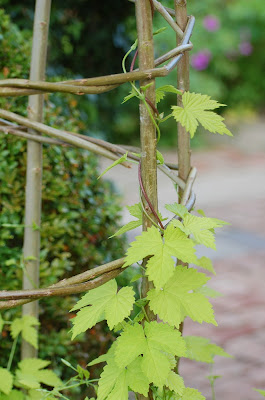First I must apologise for missing a week - I had some time off visiting universities with my son. Back at work now and when you have been away for a few days the growth is really noticeable.
| Dahlia 'Ragged Robin', Salvia elegans and Pelargonium 'Moore's Victory' providing more and more splashes of red |
Cat nap
The plantings are fluffing up nicely; Salvias, Dahlias and Pelargoniums are beginning to flower in earnest after a little sunshine and the higher temperatures mean that everyone spends more time enjoying the garden, including the cat.
| Puss-Puss has decided he looks good with these colours. I hope he isn't digesting baby blackbirds. |
| Arctotis 'Hannah' in a rosebowl |
I still find it amazing how even a couple of days of sunshine can increase flower power very quickly. A rose bowl of Arctotis 'Hannah' has become one of the stars of the show since last week.
Pastels in profusion
Meanwhile in the stockyard the colours are softer: pink, white, purple, grey and blue. Osteospermum ecklonis var. prostratum is beginning to wake up. It gives me little moments of satisfaction while I am dead-heading as I have planted it with Lobelia 'Riviera Rose' which picks up the purplish backs of the petals when the flowers close on a cloudy day and makes the little ring of violet in the centre of the flower sing on a sunny day. Dead-heading is a very important job all summer and it gives you the chance to revel in such close-up details.
Osteospermum ecklonis var. prostratum
with Lobelia 'Riviera Rose'
Right plant, right place
It is important to plant sunlovers like the Arctotis and Osteospermum in the right place or you will find that they become straggly and flower poorly; in deep shade the flowers they do produce will often sulk and refuse to open.
I finished the main stockyard plantings this week and the style is fluffy and pretty, mainly pastel but with a few shots of strong pink and dark blue. I have used a lot of our grey-decorated pots which look so good with the grey and silver foliage that loves such an open, sunny position.
| Pink Hypoestes, silver Convolvulus cneorum Lavandula x christiana, Convolvulus sabatius and pink Bacopa in a Wisley Gardener's Pot |
| Seed-grown Dahlia with Didiscus 'Madonna Mix and Cineraria maritima 'Cirrus' in a Warwick Pot |
Stalwart Salvias
The new plantings look OK now because the foliage is good, but in a week or so the flowers will become more noticeable. I am always careful to maximise the season of interest in summer plantings by including good foliage as well as plants which will flower well in late summer, even autumn, rather than burning out by July and looking tired and resentful for the rest of the season. This is where a good collection of salvias and dahlias comes in handy. In the stockyard the tall blue Salvia 'Indigo Spires' is already flowering well in big pots and will just carry on getting more and more spectacular until the first frosts. One of my favourite salvias is S. leucantha, which really hits its stride after midsummer. Its velvety flowers always attract attention and it features prominently in this week's plantings.
| Salvia leucantha |
I also have another variety, which I think is S. leucantha 'Purple Velvet', I like this even more.
| Salvia leucantha 'Purple Velvet' - asking to be fondled |
| Lavatera maritima |
| Dahlia 'Candy Eyes' with Cineraria maritima 'Cirrus' and Lobelia 'Riviera Rose' |
Major plants like these and my precious dahlias are accompanied by "minor plants" or "fillers" in the big, mixed plantings: many annuals, such as Lobelia, Didiscus caeruleus 'Madonna Mix' and Centaurea cyanus 'Black Ball' will provide flower colour and are so easy to grow from seed it is a sin not to. Foliage annuals such as Cineraria maritima 'Cirrus' are equally valuable.
| Dahlia Happy Single 'Wink' and Centaurea cyanus 'Black Ball' |
| Can someone tell me the name of this rose? Is it Ballerina? The pots below it are from a collection made in collaboration with Kew Gardens |
The Name of the Rose
Now I have a question for the rose enthusiasts among you - can anyone tell me whether the rose on the wall of the pottery next to our Kew Collection of pots is Climbing Ballerina? A customer asked me if it was Ballerina and I said I didn't think so (because I thought Ballerina was darker and had very little scent) but now I look at different versions of it online I am not so sure...
It is vigorously growing on a north wall and has a gorgeous scent on warm days. Any ideas?
Flying visit
| Humming Bird Hawkmoth enjoying the Centranthus ruber in the Courtyard Garden at the Pottery |































